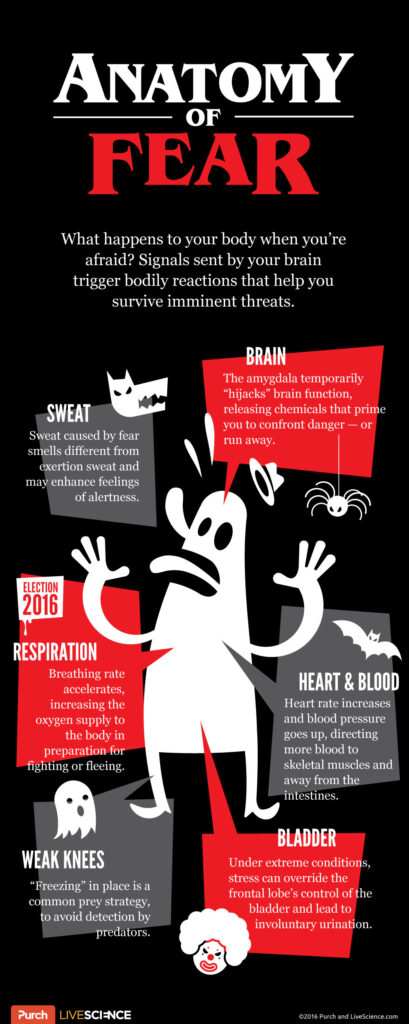What if Fear Is Not Your Enemy But Your Energy?
What if fear isn’t the problem? What if it’s actually your fuel? We’re often told to stay calm, be confident, and suppress fear but what if fear is just a misunderstood signal? That pounding heart and shaky breath don’t mean you’re weak. They mean your body is preparing for something that matters.
Fear is raw energy. It’s adrenaline, alertness, and focus trying to rise. The trouble comes when we don’t know how to handle it. Unfocused, it spirals into panic. But when directed with intention, it becomes the exact spark you need to perform at your best. Elite performers don’t avoid fear. They retrain it.
You’ve seen this in action—an athlete locking in before a game-winning shot, a speaker taking the stage with intensity in their eyes. They’re not fearless. They’ve just learned to harness fear instead of letting it take over. And the good news is: you can learn it too.
Fear Is Just Energy: The Hidden Power of Pressure
Fear often feels like a wall. Something that blocks us from speaking, acting, or performing under pressure. But what if it’s not a wall at all? What if it’s actually a surge of energy, trying to help you rise to the occasion? At its core, fear is not a weakness. It’s readiness.
When something matters to you -whether it’s a speech, a test, or a confrontation- your body reacts. Your brain releases adrenaline. Your senses sharpen. Your heart beats faster. That’s not failure. That’s your body preparing for action. Fear is your built-in alarm that says, “Get ready.”
The problem arises when we interpret that energy as a threat. We feel the butterflies, the sweat, the pounding heart and assume something is wrong. But nothing is wrong. That energy just needs to be redirected, not rejected.
Athletes before a big game. Musicians before a concert. Pilots before a night flight. They all feel it. The difference is, they don’t try to eliminate the pressure. They learn to ride it. Because when that energy is focused, it turns into sharpness, strength, and speed.
The key is to stop fighting fear and start working with it. You can’t avoid the physical rush. But you can choose how to use it. And that decision -how you channel fear- is the difference between freezing and flowing under pressure.
Inside the Body: What Fear Really Looks Like
Fear isn’t just in your mind, it takes over your entire body. The moment you sense a threat, your brain activates the sympathetic nervous system, triggering the classic “fight, flight, or freeze” response. This is automatic and ancient—wired into your biology for survival.
Your heart starts pounding to pump more blood to your muscles. Your breathing speeds up, getting more oxygen into your bloodstream. Muscles tighten, preparing you to act. Your pupils dilate, your palms sweat, and you suddenly feel very alert.
But that alertness comes at a cost. As your body powers up for action, your prefrontal cortex -the logical, decision-making part of your brain- starts to shut down. That’s why your mind goes blank during an oral test or why you can’t think straight in a tense conversation.
This is known as an ‘amygdala hijack’. The amygdala, your emotional alarm center, takes control. It sees pressure as danger, even if it’s just a math test or a performance review. So while your body is flooded with energy, your thinking brain is momentarily offline.

In this state, you might feel overwhelmed, shaky, frozen, or reactive. But here’s the key insight: nothing is wrong with you. This isn’t weakness or panic. It’s your nervous system doing its job. You’re not broken. You’re overloaded.
Understanding this helps remove shame. It’s not about “staying calm” all the time. It’s about knowing how to bring your brain back online when it goes into overdrive. And the fastest way to do that is through your breath, because breath is the bridge between body and mind.
Next, we’ll learn how to use that bridge with a simple but powerful breathing technique to switch from fear to focus.
The Focus Switch: The Breath That Brings Back Control
In moments of stress, your breath becomes short, fast, and shallow – fueling the panic loop. But here’s the powerful truth: your breath can also be the key to interrupting that loop. It’s the only part of your autonomic nervous system you can consciously control.
That’s where the Focus Switch comes in -a simple technique practiced by elite soldiers, athletes, and emergency responders to reset their minds and bodies before high-stakes moments. It’s not meditation. It’s a tool to regain command when your brain is spiraling.
Here’s how to do it:
Inhale slowly through your nose for 4 seconds.
Exhale gently through your mouth for 6 seconds.
Repeat three times.
Why it works: The longer exhale activates the parasympathetic nervous system, which counters the body’s stress response. It sends a signal to your brain that you’re safe, helping you regain calm, clarity, and cognitive control.
The Focus Switch doesn’t eliminate fear, it redirects it. That shift gives your thinking brain the oxygen and focus it needs to handle pressure with sharpness, not confusion. In just 20–30 seconds, you can bring yourself back from fight-or-flight mode.
Professionals use this method before stepping onto stages, entering negotiations, or launching into high-risk situations. You can use it anytime: before a test, a speech, or a difficult conversation—any situation where you need to handle pressure and perform under stress.
It’s small, invisible, and portable. You don’t need tools, apps, or space. Just breath, intention, and repetition. And the more you practice it, the more instinctive it becomes. Until focusing under pressure becomes your new default.
Real-Life Application: How Students, Soldiers & Speakers Use It
Pressure doesn’t care who you are. Whether you’re a student preparing for an oral exam, a soldier about to enter a combat zone, or an executive stepping onstage, your nervous system reacts the same way—by flooding your body with adrenaline. But what separates pros from panicked minds is how they respond.
Before a mission, elite soldiers don’t just gear up physically. They prep mentally. One of the first things they do is breathe. The Focus Switch helps slow their breathing, calm the body, and re-center the mind. It keeps their decision-making clear in life-or-death situations. They don’t erase fear—they direct it.
Pilots do the same thing before takeoff or in moments of crisis. Instead of letting panic rise, they use controlled breathing to override the limbic system and focus on the checklist. Their training prepares their hands, but breath keeps the mind sharp and steady under pressure.
Now bring this to a student facing a public speaking assignment. Your name is called. Your heart races. But instead of freezing, you take a breath. Then another. Then one more. With each exhale, you regain composure. In that moment, you handle pressure not by avoiding it, but by moving through it.
Even in everyday moments -a difficult conversation, an unexpected question in class, or a high-stakes interview- the Focus Switch is a secret tool. People who seem “naturally calm” often just know how to handle pressure better than most. They’ve practiced turning fear into focus.
This isn’t about being superhuman. It’s about using human biology to your advantage. Fear will always show up but now, you know what to do when it does.
The Power of Visualization During Breathwork
Breathing alone calms the body, but when paired with visualization, it trains the mind. This combination is what elite performers use to mentally rehearse success under pressure. While your breath anchors you in the present, visualization sets your direction forward -toward clarity, control, and confidence.
With each inhale, picture yourself handling the situation with calm strength. See yourself stepping up, speaking clearly, or performing with focus. Don’t wait for confidence to appear. Imagine it first. Your brain starts to believe what it sees, especially when your body is relaxed and alert.
On the exhale, release tension. Picture the fear leaving your body like steam from a valve. Let go of doubts, noise, and distractions. This isn’t daydreaming; it’s rewiring your response. You’re turning fear from something that paralyzes into something that prepares you.
Visualization helps you handle pressure before it hits. When the real moment arrives, your brain has already practiced. It feels familiar. You’ve already seen yourself succeed, and that mental image acts like a blueprint. Even when fear rises, your mind remembers the path to action.
Over time, this builds a feedback loop. The more you visualize success and breathe through the fear, the more you actually succeed. That success, in turn, reinforces your mental pattern. You stop seeing fear as a wall and start seeing it as a sign you’re ready. With breath and vision aligned, you don’t just survive pressure. You handle pressure like a pro.
Case Study: A Student’s Transformation Story
Aarav was a bright student with a quiet fear: public speaking. Every time he was asked to present, his throat tightened, his hands trembled, and his mind went blank. Even though he knew the material well, fear hijacked his ability to perform.
We started small. I introduced him to the Focus Switch method—three intentional breaths, slow on the exhale, steady on the inhale. He practiced before speaking, even when reading aloud in small groups. With each attempt, his nervous system learned how to handle pressure rather than panic.
Next came visualization. While breathing, Aarav imagined himself walking to the front of the room with steady steps. He pictured himself speaking clearly, making eye contact, and finishing strong. This mental rehearsal trained his brain to expect success, not failure.
His turning point came during a school assembly. A speaker canceled last minute, and Aarav stepped up. He paused backstage, took his three breaths, visualized the outcome and then walked on confidently. His voice didn’t shake. His message landed. His classmates saw a different side of him.
Later, he told me, “I still get nervous. But now I know what to do with it.” That’s the real win. Not eliminating fear, but learning to handle pressure with focus. Aarav’s story shows what happens when you stop trying to fight fear and start working with it instead.
The Reframe: Fear as Fuel, Not the Enemy
We’re taught to see fear as a red flag. Something to avoid, suppress, or be ashamed of. But in reality, fear is simply a signal. It means something matters. The presence of fear doesn’t mean you’re weak. It means you care. And that’s powerful.
Think about it: the same fear that tightens your chest before a big speech is the same energy an athlete feels before a race. What sets them apart isn’t their fear. It’s how they handle pressure. High performers don’t eliminate fear; they focus it.
Once you start seeing fear as fuel, your response shifts. Instead of spiraling into panic, you pause. You breathe. You use the Focus Switch. You take control back from your nerves and give it to your thinking brain. That’s how real confidence is built.
Learning to handle pressure doesn’t mean pretending fear isn’t there. It means learning to stay grounded even when fear is loud. It means being ready when the stakes are high, because you’ve trained your body and mind to respond, not react.

Fear only becomes a problem when you misuse it. Let it stay wild, and it will overwhelm you. But direct it with breath, with focus, with intention and it becomes drive, alertness, and presence. Fear isn’t your enemy. It’s your energy, waiting to be used.
Fear Doesn’t Stop You. Misusing It Does.
Fear is not the enemy. It’s the energy before the breakthrough, the heat before the spark. Every time your heart races before a big moment, your body is telling you that what you’re about to do matters. That’s not weakness—it’s readiness.
Most people try to fight fear, suppress it, or run from it. But that only makes it stronger. The real secret is learning to redirect it. When you breathe, focus, and visualize, you take the same fear and turn it into clarity, control, and courage.
This is how professionals -from athletes to leaders- handle pressure. They don’t eliminate fear. They practice using it. They train themselves to respond, not react. And the more you do this, the more natural it becomes.
Whether you’re walking into an exam room, stepping on stage, or facing a tough conversation, the method is the same: slow the breath, quiet the panic, see the outcome. This is how you handle pressure. Not by wishing fear away, but by working with it.
So the next time you feel fear rising, don’t fight it. Focus on it. Because fear doesn’t stop you. Misusing it does. Focus is just fear, redirected.
FAQs on Focus Over Fear: The Mental Trick That Helps You Handle Pressure Like a Pro
What does it mean to handle pressure effectively?
Handling pressure means staying calm, focused, and in control during high-stress situations, instead of panicking or freezing.
Is fear always a bad thing when performing under pressure?
No, fear is just energy. When properly directed, it can enhance focus, speed, and performance.
How can I turn fear into focus?
By using techniques like slow breathing, visualization, and mindset reframing, you can redirect fear into concentration and performance power.
What is the Focus Switch method?
The Focus Switch is a breathing technique: inhale for 4 seconds, exhale for 6 seconds, repeated 3 times to calm the nervous system and regain control.
Why do I freeze during stressful situations?
That’s due to an “amygdala hijack,” where the brain’s fear center overrides logical thinking under stress. Controlled breathing helps reverse this.
How does breathing help you handle pressure?
Breath regulates your nervous system. A slower exhale calms the body, activates the thinking brain, and reduces panic.
Can breathing techniques really stop fear?
They don’t stop fear but they help you work with it. Controlled breathing reduces overwhelm and improves clarity.
What’s the science behind handling pressure through breathwork?
Deep, slow breathing activates the parasympathetic nervous system, which counteracts the body’s fight-or-flight stress response.
Who uses the Focus Switch method in real life?
Soldiers, athletes, pilots, public speakers, and students all use it to handle pressure in high-stakes moments.
Can students use this technique during exams or presentations?
Absolutely. It’s especially effective before tests, oral exams, or public speaking to reduce anxiety and improve focus.
What is visualization and how does it help under pressure?
Visualization is mentally rehearsing success. Paired with breathwork, it builds confidence and prepares the brain for real-world execution.
Can fear actually boost performance?
Yes, when used properly. Fear heightens awareness and energy—it becomes power when focused.
Why do people panic even when they’ve practiced?
Because fear triggers a biological stress response. Without tools like breathwork, the body may still react with panic.
How can I train myself to handle pressure consistently?
Practice the Focus Switch daily, pair it with visualization, and reframe fear as performance energy.
Is it possible to eliminate fear entirely?
No. Fear is natural. The goal isn’t to erase it, but to direct it with intention so it fuels action.
What are the signs that I’m not handling pressure well?
Blank mind, shaky hands, rapid heartbeat, and loss of focus are all signs of being overwhelmed by unmanaged fear.
How long does it take to learn to handle pressure effectively?
You can feel results in minutes, but long-term change comes from consistent practice over time.
Does handling pressure mean being fearless?
No, it means being functional and focused in spite of fear—not the absence of it.
What’s one quick tip to handle pressure instantly?
Pause, take three slow breaths (Focus Switch), and visualize success—that moment of control resets your brain.
How does changing your mindset about fear help?
Seeing fear as energy instead of danger changes your entire response. It empowers you to focus instead of freeze.
~Aishwarya Galagali





